Winchester Cathedral: "A Pretty Easy Way of Dawdling Away One's Time"
by John P. Seely
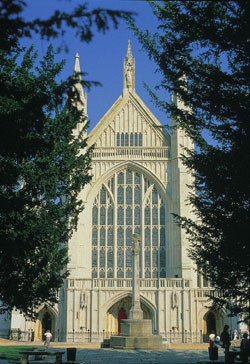 Winchester Cathedral is one of the world's
greatest churches, and arguably England's most magnificent
cathedral. Its grandeur is enhanced by its setting in Winchester,
a delightful, modest city of broad streets and narrow alleys with
history written at every corner, lying in a hollow in the downs
in the ancient heart of the southern English countryside. The
cathedral itself is a treasure house of art, both ancient and
modern, and housed in a magnificent, light-filled, powerful
edifice that is built in a style uniquely English, perpendicular
-- Gothic, a rather clumsy term for such elegant
architecture. Winchester Cathedral is one of the world's
greatest churches, and arguably England's most magnificent
cathedral. Its grandeur is enhanced by its setting in Winchester,
a delightful, modest city of broad streets and narrow alleys with
history written at every corner, lying in a hollow in the downs
in the ancient heart of the southern English countryside. The
cathedral itself is a treasure house of art, both ancient and
modern, and housed in a magnificent, light-filled, powerful
edifice that is built in a style uniquely English, perpendicular
-- Gothic, a rather clumsy term for such elegant
architecture.
Once an important walled Roman town, Venta Belgarum, it
later became the Saxon capital of Wessex, Wintanceaster,
before becoming the capital of England under King Alfred the
Great. By the end of the 10th century, Winchester could boast of
being home to the greatest ecclesiastical complex north of the
Alps. Winchester was a royal city under Wiliam the Conqueror and
his treasury, the Hoard, was kept here.
The first church in Winchester was built by King Cynegils, first
Christian king of Wessex. He was converted to Christianity by St.
Birinus who had been sent by Pope Honorius to complete the
conversion of the English that St Augustine had begun. His son,
Cenwalh (or Coenwealh) endowed more lands and later built a new
church. This first became a bishop's seat in the 670s and St
Birinus' remains were later moved here. This cathedral, the Old
Minster, was built on the site of a much earlier Roman church
which had later been used for pagan worship by the Saxons. (If
this seems confusing remember that England, Christian under the
Romans, was sacked by marauding pagans, the Vikings, who drove
the original Celtic inhabitants from their lands to the more
inaccessible corners of the British Isles. It was these newer
"English" that now needed converting.)
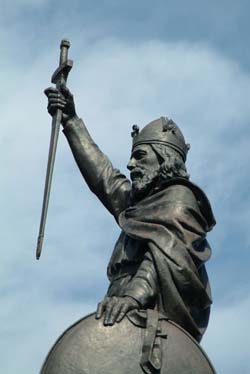 Alfred became
King of Wessex at a time when England was suffering again from
wave after wave of marauding, pillaging Vikings. After one
particularly ferocious, and completely unexpected, raid in the
winter of 878 led by Guthorm of East Anglia, Alfred was left
perilously close to defeat. By hiding in Athelney Marshes, he
managed to rally his supporters and led an attack that defeated
the Danes at the Battle of Edington. As part of the peace treaty,
Guthorm converted to Christianity and was allowed to return to
East Anglia. Alfred then took steps to secure his kingdom. He
built a series of fortified strongholds (burhs) and constructed
the first English fleet. Consequently he is often remembered
today as the father of the British Navy. Alfred became
King of Wessex at a time when England was suffering again from
wave after wave of marauding, pillaging Vikings. After one
particularly ferocious, and completely unexpected, raid in the
winter of 878 led by Guthorm of East Anglia, Alfred was left
perilously close to defeat. By hiding in Athelney Marshes, he
managed to rally his supporters and led an attack that defeated
the Danes at the Battle of Edington. As part of the peace treaty,
Guthorm converted to Christianity and was allowed to return to
East Anglia. Alfred then took steps to secure his kingdom. He
built a series of fortified strongholds (burhs) and constructed
the first English fleet. Consequently he is often remembered
today as the father of the British Navy. Several
anecdotes have come down to us, which, even if not true,
demonstrate Alfred's character. He is probably best remembered by
schoolboys, not for wining any battles, but by not being any good
at cooking! This is said to have occurred whilst he was in hiding
in Athelney. According to the story, he begged shelter in a
peasants hut. The housewife, not recognizing him, asked him to
mind some cakes she was cooking, but being understandably rather
preoccupied with weightier affairs, he allowed the cakes to burn,
and then had to put up with being scolded, something he is
supposed to have taken good-naturedly.
Glover & Miles writing in their 17th century book The
Kings of England had this tale to tell of Alfred, who, whilst
in Athelney,
"....despaired not, but, in the habit of
a minstrel going forth, thence came to the camp of the Danish
king accompanied but with one trusty servant only; where he,
tarrying certain days, was suffered to go into every place and to
play upon his instruments, as well before the king as others, so
that there was nothing in the camp secret which he understood
not."
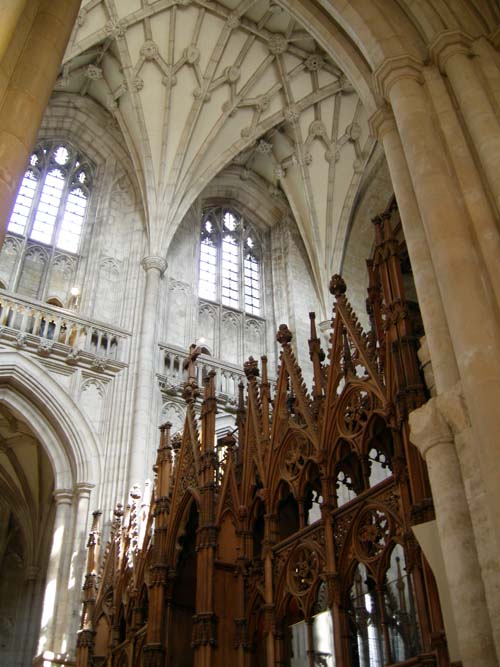 He then went on to successfully attack and capture the
Danish camp "....and slew of them a great
number." He then went on to successfully attack and capture the
Danish camp "....and slew of them a great
number."
Alfred was a scholar and educator as well as a soldier and
strategist. He laid the foundations of English Literature,
translating many books into Anglo-Saxon to make them more
accessible. Translations included such medieval favorites as
The Consolations of Boethius, Bede's Ecclesiastical History of
the English Nation and the History of the World by
Orosius. The Anglo-Saxon Chronicle, the first great
vernacular history of England, owes its origins to Alfred the
Great who first conceived of the idea of a national history
written in English.
On his death, Alfred was first buried at Old Minster, but after
his ghost was seen walking around at nights, his remains were
moved to the New Minster. This was built close by the Old Minster
in 892 by his son, Edward the Elder. Today, in the churchyard of
St Bartholomew's, by the remains of the New Minster and just
below the east end, lies a simple grave marked only with a cross.
This is popularly thought to be where King Alfred the Great is
buried, though without any real justification.
In 960, Old Minster was reformed and a Benedictine Monastery
added, St Swithin's priory. This survived the next 600 years
until its destruction during the Reformation. The two minsters
and a convent, Nunnaminster, founded by Alfred's widow were
enclosed in walls in 964 to isolate them from the growing city.
By the time the Abbey was closed by order of Henry VIII,
Nunnaminster was among the largest in England. The abbey site was
gifted to the city by Queen Mary on the occasion of her marriage
to Phillip II, King of Spain at Winchester cathedral. A private
house, now the Lord mayor's residence, was later built on part of
the site, and the guildhall was built on another section. The
ruins of the abbey were partially excavated in the 1980s and can
be visited today.
St. Swithin's day, gif ye do rain,
for forty
days it will remain;
St. Swithin's day an ye be fair,
for
forty days 'twill rain nae mair.
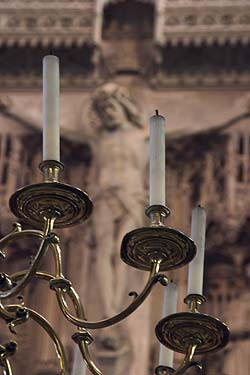 Every Cathedral
needs its saint and Winchester is no exception. St Swithin (or
properly Swithun) was born in Wessex and educated in the Old
Minster. He was named bishop of Winchester in 852 but apart from
being remembered for his humility and services to the poor,
little else is known about him. The only miracle attributed to
his life is when he restored an old woman's dropped basket of
eggs. He died on July 2 862 and was buried at his request in the
churchyard so that "the sweet rain of heaven may fall upon
my grave". Every Cathedral
needs its saint and Winchester is no exception. St Swithin (or
properly Swithun) was born in Wessex and educated in the Old
Minster. He was named bishop of Winchester in 852 but apart from
being remembered for his humility and services to the poor,
little else is known about him. The only miracle attributed to
his life is when he restored an old woman's dropped basket of
eggs. He died on July 2 862 and was buried at his request in the
churchyard so that "the sweet rain of heaven may fall upon
my grave".
His body was to have been removed for reburial on July 15th 972
following his canonization, but was delayed by violent rain,
probably the origin of the superstition that if it rains on St
Swithin's day we are in for 40 more wet days. His remains were
eventually successfully placed in a splendid shrine in the
church. From that moment on, miracles were reported and
Winchester became a place of pilgrimage. His relics were moved
into the new Norman cathedral in on July 15, 1093. Then, on the
night of September 21st, 1538, his shrine was demolished by
officers of the reformation. His remains were removed and
subsequently lost.
Once the Normans had settled in following their successful
invasion of England in 1066, they consolidated their reign by
embarking on an extensive rebuilding of England's Cathedrals and
churches using the Norman-Romanesque style they brought with
them. The Saxon bishop of Winchester was replaced by a Norman
bishop, Bishop Walkelin, who oversaw the building of an ambitious
Norman Cathedral, gradually demolishing the Old Minster as work
progressed. Walkelin's cathedral was to be the longest in the
world at that time, in fact it was13 meters longer than the
present church.
The foundations of the Old Minster were excavated in the 1960s
and the outline of the walls marked out in brick. Standing at the
west entrance to the nave, the original church lies at an angle
slightly to the north east of the modern structure but sharing
the same nave. It's as if the Norman church was dropped onto foot
of the original, but somewhat askew.
The Cathedral at heart is Norman but has been altered and added
to many times in its life. In particular, the nave was completely
remodeled in the 14th century under the supervision of Bishop
William of Wykeham, an influential statesman and Chancellor of
England, often considered the father of the public school system.
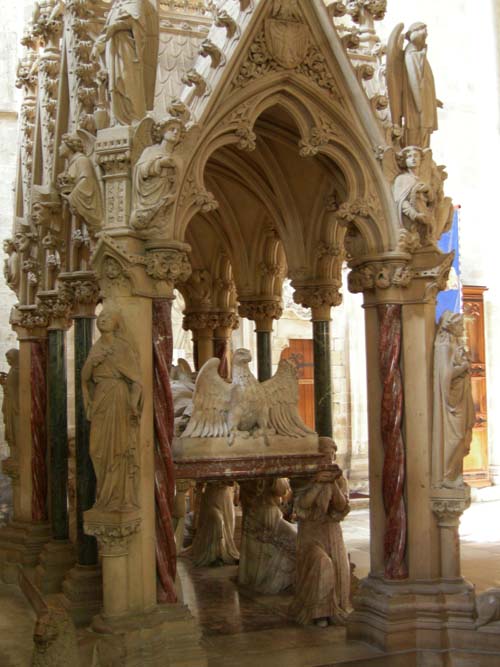 Towers have been proposed, replaced and removed
several times, sometimes due to poor workmanship as in the case
of the central tower, which collapsed in 1107. The ground has a
high water table, a common problem when building on a marsh, and
this has caused many structural problems over the years.
Winchester is probably the only cathedral in the world that had
to employ a deep-sea diver as part of a team working for 6 years
to underpin the walls, starting in 1905. If you want proof of the
high water table, go into the original crypts under the eastern
arm in winter, and they will be flooded. A powerful piece of
modern sculpture stands in the middle of the flooded floor. Towers have been proposed, replaced and removed
several times, sometimes due to poor workmanship as in the case
of the central tower, which collapsed in 1107. The ground has a
high water table, a common problem when building on a marsh, and
this has caused many structural problems over the years.
Winchester is probably the only cathedral in the world that had
to employ a deep-sea diver as part of a team working for 6 years
to underpin the walls, starting in 1905. If you want proof of the
high water table, go into the original crypts under the eastern
arm in winter, and they will be flooded. A powerful piece of
modern sculpture stands in the middle of the flooded floor.
Some of the more unusual items to be seen in the cathedral are
the wooden mortuary chests containing the relics of pre-conquest
Kings and Bishops. Bones were placed in these chests in the 1520s
but got mixed up when Cromwell's Parliamentary soldiers rode
their horses into the cathedral and started to vandalize it,
taking down the mortuary chests and using the bones as missiles
to break the stained glass windows. Of course the bones got mixed
up when they were eventually returned to the chests. The windows
fared little better, and when repaired the glass was replaced
haphazardly; you can still see this today.
A mere list of the treasures to be seen in Winchester would make
boring reading but mention must be made of the Winchester Bible,
a beautifully illuminated 12th century bible that was produced
here and is on permanent display.
Izaak Walton (1593-1683), author of one of the most delightful
English books, The Compleat Angler, is buried in the
fisherman's chapel. Although written during the upheavals of the
civil wars it is a gentle discourse on the pleasures of fishing
and the beauties of nature. It is written in the form of a
discourse between a fisherman, a hawker and a hunter who find
they traveling together. Despite its age, it is still very
accessible to the modern reader. If you need to know how to tie a
frog on a hook or how to gut a pike then this is the book for
you.
Some of his philosophies are still relevant today, as here when
he talks about contentment:
Can any man charge God, that He hath not given
him enough to make his life happy? No, doubtless; for nature is
content with a little. And yet you shall hardly meet with a man
that complains not of some want; though he, indeed, wants nothing
but his will; it may be, nothing but his will of his poor
neighbour, for not worshipping, or not flattering him: and thus,
when we might be happy and quiet, we create trouble to ourselves.
After the restoration of the monarchy life gradually became
more peaceful. Winchester became such a quiet backwater that in
the 18th century, Canon Edmund Pyle could write that being at the
cathedral was "a pretty easy way of dawdling away one's
time: praying, walking, visiting, and as little study as your
heart would wish."
More Information:
We regret that we no longer have the resources to maintain up-to-date links and/or hours and pricing details for the various sites and attractions listed on this website. For more information about the location(s) listed above, please use your favorite search engine or visit Wikipedia.
John Seely is a freelance writer living in Thailand, who returns regularly to England. He writes regularly for local magazines and has also been published in International Living, Transitions Abroad
and Gonomad. Samples of his work can be found at http://www.johnpseely.com/Travelarticles.htm.
Article © 2006 John Seely
Interior photos (screen and tomb) © 2007 Moira Allen; candlelabra photo courtesy of Britainonview.com; all other photos courtesy of the City of Winchester Tourism Board.
|
